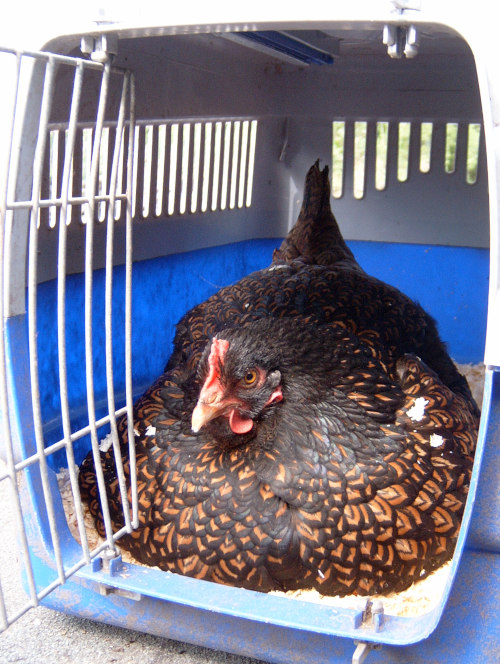Can you move a broody hen?

You can move a broody hen and her nest of hatching eggs.
It is sometimes necessary to move broody hens and if you pick the right time of day it can be done easily with little risk of the hen leaving the nest. There is always the chance she will abandon the nest and not return to her clutch but if you are careful, all will be well.
You should always separate broody hens from the rest of the flock if you can because they are disruptive.
Hens often go broody in the communal nest boxes in the coop and they can't be allowed to stay as it causes fighting, mixed up nest boxes and broken eggs. It is OK to move a broody hens to a broody coop or pen so as they can rear their chicks in peace away from the flock.
Below: I like to use large animal crates as broody nests, they are easy to move, secure and easy to clean out after the hatch.

I can move broody hens with a 80 to 90% success rate. It is breed and temperament dependant. My Barnies are really easy to deal with for the most part.
How to move a broody hen:
Always be ready and prepared ahead of time.
There are two ways to move a broody hen, The first is when the broody leaves her nest to eat and poop, you just make sure she goes back on the new nest. Hens get off the nest for around 15 minutes or so at a time and this gives you time to move the eggs and present her with the new nest when she returns.
Below: Wear gloves and be prepared to get pecked to death.
Have the new nest ready with a hot bottle and them move the eggs when she gets off. You may need to provide your broody hen with a dish of food and water and remove her from the nest and allow her to eat and drink.
The second is to lift her gently of the old nest and move her to the new one. The problem with this method is hens can be quite attached to their chosen nest and you may have a fight on your hands. Broodies can be grumpy and I suggest leather gardening gloves!
With seasoned hens that are used to being handled a nest move is easy, some of mine even tuck the eggs back under themselves of their own accord one at a time as you present them to her.
- Dusk is the ideal time.
- Prepare the new nest and location.
- Warm the new nest with a hot water bottle for a few minutes.You wouldn't want to be getting into a cold bed.
- The location must be dark and without bright lights. If you can read a newspaper it is too light.
- When you pick her up make sure there are no egg hiding under her wings and around her legs or she may flap and break them when they fall.
- Move quickly. Getting someone to move the eggs from one nest to the other while you move the hen can help.
- Carry her quickly and support her legs and body with your hand to minimise her movement.
- For the first night she must be kept confined and not allowed the run of the broody coop or she may try to move the nest.
Luckily most of my hens are used to being shuffled about and with some of them all I have to do is present them with the nest in a large dog crate and they take straight to it and settle themselves down.
What to do if a nest move goes wrong:
Livestock is to some extent unpredictable and things do go wrong sometimes.
There are two choices when things go tits up moving a broody hen, you can either return her to the original nest and try again the next night or you can shut her up in the dark in her new nest and hope she settles.
Where do you put a broody hen?
Broody hens need their own space. I use plastic moulded dog crates for the purpose as they are secure and easy to move. You can also cover them with cloth or towel to darken the environment if your hens are a little skittish.
The other advantage is you can put them in a run when they hatch and they are easy for the chicks to get in and out of.
You can make or buy special broody coops that are all on the same level and have no perches. It is also important to have the run of a broody coop covered if you have a lot of rain as wet chicks will perish easily.
